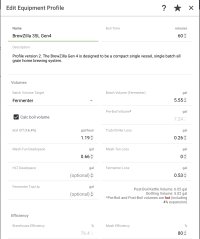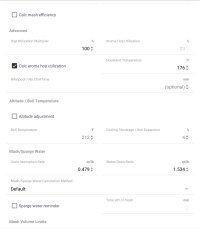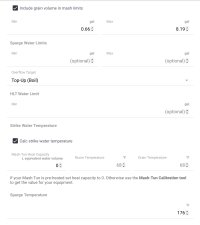I received my 110V Gen4 Brewzilla the other day and brewed a simple 5 gallon batch yesterday. I am coming from stovetop BIAB brewing indoors (condo). Here's what I found and had a few issues that can hopefully be resolved:
1. You definitely need to drop the heating element to about 40% while mashing. I initially left it at 100% and was getting heating overshoots up to 8F(!)
2. My mash got stuck quite a bit near the beginning. I was constantly stirring until finally it seemed to be able to drain and flow through the pump well. I don't know why the pump also has a % setting, as it actually seems to turn the pump on and off. You can instead control flow through the ball valve on the recirc arm which seems to make a lot more sense to me.
The bad:
1. When it came time to drain into my fermenter, I used the drain at the bottom, without the pump. It was flowing fine until there was about a gallon left in the bottom of the Brewzilla. No amount of stirring, shaking, or turning the pump on would lodge it loose, so I ended up having to dump that wort. There was a clog at the pump I had to disassemble the bottom tubing and put it all back together. It was fine as I ran through cleaning solution, etc.
I have a hop spider and used it for some of the hop pellets but not all. The video I was watching didn't use any and it seemed fine. I think this was my issue. The false bottom was covered in hop sludge but so was the real bottom, and drain, which was the issue. I will use a hop spider next time, and I will also increase my grain crush size. I only have about 2 oz of hops into the wort directly. My crusher was set below 0.03 so I'll bring it back to that.
2. No physical manual with the device? I had read the PDF earlier but it would be nice to have something to refer to. The manual itself could use some work too as things like setting the heating element % aren't exactly intuitive. There are a number of settings not referenced in the manual.
So with that said, should I have used the pump for getting wort into the fermenter? Through the recirc arm or the drain? Positioning was another thing I will have to consider. The brewzilla itself it tall, plus pulling out the malt pipe makes it a bit ridiculous working at counter height. I wanted it high enough to drain into my fermenter (I use corny kegs for the most part), but next time I was thinking I would have the Brewzilla on the floor and use the recirc arm to drain the wort.
Overall I'm confident I'll be able to improve the performance and there's a lot of nice things about this unit that improve on the
I also had my first brew on the Gen 4 this weekend so I'll add on to this.
Heat: I filled the unit all the way to the top so I could heat my mash and sparge water together. Then drained off the sparge water into an insulated cooler before starting to brew. Heating 9+ gallons of water took about 1.5 hrs so you definitely have to plan early to do that. Agree with 40% heating during mash. There were still some swings in temp but more controllable with the heating element turned down.
Pump: I knew that the pump would pulse on and off when the % is lowered from 100% but I am not a big fan of that. I guess I am old school and always thought that constantly turning something on and off will decrease its life span. I plum forgot all about using the ball valve to restrict flow so I ended up leaving the pump at 100% and just turning it on for a few seconds then off every 10 minutes or so. Next time I will definitely use the ball valve.
Boil: Based on a video from MB, I decided to put in a BIAB bag before inserting the malt pipe. There was some grain residue in it when I pulled it out after the mash but not enough to matter so I'll probably skip that next time. The stuff that was in the bag was probably a result of too fine a crush (see next paragragh). I did use a hop spider. There was still a little residue under the false bottom but not enough to clog the pump. I'll continue using the hop spider just for peace of mind.
Crush: coming from BIAB brewing I still had my crush too fine. Will definitely increase the size next time. That along with lots of flaked grains in this batch caused my drain off to take FOREVER. I think a larger crush and adding some rice hulls should help next time.
Manual: There is definitely no manual included but I had printed a copy from online and put in a notebook in the brew shed for reference.
Neoprene jacket: a total bear to get this thing on. The design has the velcro connection seam right under the pump return pipe with the flap that covers the return pipe connected at that same point. I literally thought I was going to break something trying to get it on. I emailed kegland and suggested placing the velcro seam somewhere else and just have the pipe flap as a separate piece that can be added over the pipe with velcro.
Cleaning: this was a breeze. My unit was right next to the sink so I just ran the pump return arm/hose into the sink and could easily use the pump to run cleaner, water and sanitizer through the unit without have to move it at all. I had mine set on an overturned pot so that it was about a foot off the floor and found this to be a good working height.
Transfer: I did use the pump to transfer to the fermenter and that was great. You don't need the Gen 4 to be higher than the fermenter. Just run a hose from the spigot up and into the fermenter. Once I tuned the pump on, it took all of about a minute to empty every drop.
Lastly - be sure you are paying attention to your display screen. Double check often to make sure heat is not on when it should be off and the pump is not running when you disconnect the overflow or open/close any valves, etc. I could see getting in a hurry and creating a mess. Fortunately this did not happen but I was checking things often.
I definitely learned alot. Overall, the brew was a success and with a few tweaks next time will be better.









































![Craft A Brew - Safale BE-256 Yeast - Fermentis - Belgian Ale Dry Yeast - For Belgian & Strong Ales - Ingredients for Home Brewing - Beer Making Supplies - [3 Pack]](https://m.media-amazon.com/images/I/51bcKEwQmWL._SL500_.jpg)



















